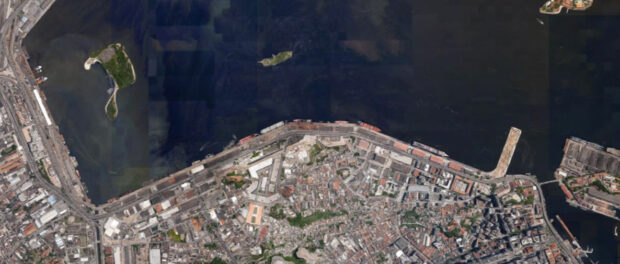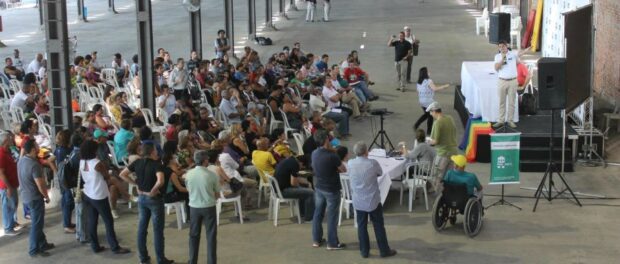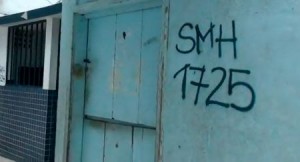
For the original in Portuguese by Claudia Antunes published in Vozerio click here.
The construction of subsidized housing for low-income families in the Port Region of Rio de Janeiro has been advocated by urban planners and social movements for six years, since the port regeneration project that goes by the name of Porto Maravilha (Marvelous Port) was launched in 2009. The plan, however, was only developed now due to a requirement launched by the Ministry of Cities. A total of 5,100 units will be built by 2026.
In mid-August, dozens of people participated in a two-day conference in Warehouse 6 in Rio’s port. There were residents of the Port Region, housing activists, urban planners, and authorities and technicians from the city’s Housing Secretariat (SMH) as well as from Instituto Pereira Passos, the city’s urban planning agency.
After heated discussions, the conference approved–first in workshops and later in a plenary–the final version of the Porto Maravilha Social Housing Plan.
The construction of subsidized housing for low-income families in the Port Zone has been advocated by urban planners and social movements for six years now, since the Porto Maravilha project was launched in 2009, during the first term of Mayor Eduardo Paes of the Brazilian Democratic Movement Party (PMDB). It was feared that the increase in real estate value would expel original residents from the region.
The plan, however, has only now been prepared due to a requirement from the federal Ministry of Cities. Called for by the Board of Trustees of the FGTS (Government Severance Indemnity Fund), the Ministry passed a normative ruling in December of last year that imposes conditions for the use of the FGTS in Urban Operations by Consortia (OUC) such as that of the port. The OUC is an instrument created in the federal City Statute that allows for the creation of special urban rules for the development of a municipal zone. One of the requirements of this normative ruling is precisely the preparation, “in a participatory manner,” of social housing projects.
Urban planner Orlando Santos Jr. of the Metropolis Observatory, one of the participants of the conference in August, said that the approval process of the plan for the port was an exception in the hardly-democratic trend that has marked the interventions in Olympic Rio. “There was indeed a dialogue at the conference, contrary to what happens in all urban policy projects of the city,” said Santos Jr., who is a professor at the Institute of Urban Research and Planning (IPPUR) at the Federal University of Rio de Janeiro (UFRJ).
The conference itself was not foreseen in the discussion of the plan, which began in June with public hearings. But the Housing Secretariat and CDURP (Urban Development Company of Rio de Janeiro’s Port Region) agreed to broaden the discussion. “Building this process here was not simple, neither within the government nor with the social movements,” said sociologist Alberto Silva, president of CDURP, when giving a speech at the end of the conference at Warehouse 6.

FGTS and the Port
The Urban Operation of the Port of Rio is, for now, the only one in Brazil that uses FGTS funds, managed by the Caixa Econômica Federal bank. In 2011, a fund from Caixa whose shareholder is the FGTS–that is, workers with signed work contracts–purchased the 6.4 million real estate titles, or CEPACs (Certificates of Additional Construction Potential bonds), launched by the City to finance the regeneration of the Port Zone. At the time, they paid R$3.5 billion (US$2.05 billion in 2011) for them. The CEPACs give construction companies who want to invest in the region the right to erect buildings taller than originally allowed.
The three neighborhoods in the Port Zone–Gamboa, Saúde, and Santo Cristo–occupy five million square meters, almost the size of the entire beachfront of the South Zone of Rio. The CEPACs, however, can be used only in the reclaimed area that was created in the early 20th century for the construction of the port–a total of 1.2 million square meters. The rest of the land corresponds to the historic sector, which operates under special architectural and cultural preservation rules.
In the land filled area, almost all of the land was public, most owned by the federal government. By purchasing the entire batch of CEPACs, the Caixa fund offered to negotiate them, along with this land, so that at the end of 15 years a total of R$8 billion could be delivered to the Public Private Partnership (PPP) that manages construction works in the region. The PPP is comprised of CDURP and the New Port Concessionary, which in turn is comprised of the construction companies Odebrecht, OAS, and Carioca Engenharia.
From the beginning there was criticism due to the fact that these PPP funds did not include either affordable housing or the upgrading of the Morro da Providência favela, which is in the Port Zone. The newly-approved social housing plan came after the Caixa fund requested an additional R$1.5 billion earlier this year from FGTS to give to the PPP of the port.
Laiza Fabiola Martins de Santa Rosa, executive manager of the National Management of Real Estate Funds (Gerência Nacional de Fundos Imobiliários) from the public bank, said that using more FGTS resources was a “question of strategy.” During a slump in the real estate market, it was best, according to her, to use more shareholder money than to sell assets from the fund–CEPACs, land, and participation in enterprises already negotiated in the Port Region.
“Even if the fund had assets to sell, if they were sold right now when the market has not been doing well, this could be bad for the shareholder,” said Laiza. “These R$1.5 billion guarantee that the construction will be completed and that the fund will be able to monetize and negotiate the assets it carries within a deadline in which the market can provide the best prices.” Together with the new funding from the FGTS, she added, the validity period of the fund went from 15 to 25 years. “This is precisely the strategy of capturing more value over time.”
According to Laiza Santa Rosa, Caixa has already negotiated 43% of the 6.4 million CEPACs, a large majority of them by means of exchanges in which the fund comes in as a partner in projects in the Port Zone. However, only 8.76% of the CEPACs negotiated correspond to construction projects that have already begun. The buyers of the remaining 35% are waiting for the area to increase in value or for a better time to launch new projects. When asked if she thought the project was going well, she answered: “Not in terms of the volume of real estate projects that we were expecting, but it is going well in terms of consumption of the CEPACs.”
One of the demands of residents of the Port Zone is that public lands in the “CEPACated area”–in the jargon that has become common in the region–also be set aside for social housing. “Look, we didn’t discuss this with the City,” said Laiza. “But that is a matter of financial feasibility, because the developer is the one doing the math. If the developers understand that it has an acceptable rate of return…”
The plan
The negotiations of the social housing plan for the port changed the original project by the City and CDURP significantly. “What resulted was neither what would have been written by society nor that presented by the government,” said Orlando Santos Jr.
The initial diagnosis included the need to build 3,000 apartments for low-income families earning up to six minimum wage salaries. In the final version, the goal is to reach 10,000–although there is only a construction deadline for 5,100. Originally, most would be in other neighborhoods in the central zone of the city, outside the Urban Operation region. The City has pledged to identify new empty lands and properties in the Port Zone itself.
Also new was the provision for [a permanent] social rent, or subsidized rent, for families with incomes of up to eight minimum wage salaries–a model used in European and American cities which helps regulate the rental market and which will be applied for the first time in Rio. The idea is that there be 1,500 residences for social renting. An additional 250 properties will be destined to small businesses in the area. The plan also includes the construction of new schools and health clinics–yet another omission from the original project for Porto Maravilha, despite the declared intention of increasing the population in the area from 23,000 to 100,000 people over a 15 year period. One problem is the deadline for the delivery of the 5,100 homes, which starts in 2020 and ends in 2026–ten years from now.
Ten days following the conference at Warehouse 6, the Management Board of the Municipal Fund for Social Housing met at City Hall to ratify the plan. “In 2026, I’ll be dead,” joked former Green Party (PV) councillor Sonia Rabello, president of the Federation of Rio Neighborhood Associations. She insisted that the city set aside funds from the Public Private Partnership to build social housing.
The budget for the housing plan is yet to be detailed. The City has committed to presenting it within six months. The original idea was that the better part of the resources would come from the federal Minha Casa Minha Vida (public housing) program–which at the moment has undergone cuts due to fiscal adjustments. Housing Secretary Carlos Francisco Portinho said that the budget may be complemented with city funds and with measures from a package that the city has just sent to Congress.
One of them includes a provision that in order to license large projects in the city–and this would be buildings with 300 to 500 apartments, but the upper limit has not been stipulated–there must also be construction of homes for low-income residents of the downtown area of Rio. Another is the possibility that lands with empty or underutilized plots be declared Areas of Special Social Interest, which would allow for less costly expropriations.
A third measure requires fewer parking spaces in buildings in the central region and the Port–areas that are well serviced by public transportation. Portinho also mentioned that the public bidding process that has been agreed upon for the construction of social housing does not require specific legislation for the Port–that is, a company that participates in a bid to build social housing in any area of the city can do so even on land in the Port Zone, which is higher in value.
The secretary recognized that the “trigger” for the Port plan was the regulation by the Ministry of Cities, but said that “the City understood that it was the right time for these things to come together.”
“It was in the interest of the City, upon intervening in the Port, to better regulate the issue of social housing and of urban equipment. I believe the plan will serve as an example to other regions of the city,” said Portinho, who took office at the end of January and is from the Social Democratic Party (PSD), also the party of the Minister of Cities, Gilberto Kassab.
Providência
 The absence of a program for popular housing in the Port Region was one of the obstacles for urbanistic reform in the Providência favela. Launched in 2010, the project originally included the removal of 670 families–but most of them refused to leave in exchange for [temporary] social rent or to move to housing complexes in zones farther away from the downtown area of Rio. The upgrading works ended up being suspended by the Justice Department at the end of 2012 in an initiative by the Public Defenders’ Office. And until today, the only social housing buildings linked to it—a set of 118 apartments on Rua Nabuco de Freitas, behind the railway tracks of the Central Station (Central do Brasil)—have not been finished.
The absence of a program for popular housing in the Port Region was one of the obstacles for urbanistic reform in the Providência favela. Launched in 2010, the project originally included the removal of 670 families–but most of them refused to leave in exchange for [temporary] social rent or to move to housing complexes in zones farther away from the downtown area of Rio. The upgrading works ended up being suspended by the Justice Department at the end of 2012 in an initiative by the Public Defenders’ Office. And until today, the only social housing buildings linked to it—a set of 118 apartments on Rua Nabuco de Freitas, behind the railway tracks of the Central Station (Central do Brasil)—have not been finished.
According to Portinho, the company abandoned the construction works because “it couldn’t take the social dialogue in the area”—“the dialogue with the parallel power (a local euphemism for drug traffickers), let’s put it that way,” he explained. He said that a new bid is underway to complete the buildings. With regards to the construction works in Providência—executed by the Rio Faz consortium with the same construction companies as the PPP of the Port—only the cable car, which connects the Central Station to the Port seafront with a stop in the favela was completed (the community halted other construction in court).
The secretary believes chances are slim for upgrading works in the favela to be restarted. “The judicialization of the problem was not good for the residents or for the city. I’ll complete the building on Rua Nabuco de Freitas, but we already consider the upgrading work as finalized. An agreement now would have to come much more from the residents than from the City. If they want to restart it, I’m open to it. But the truth is that there is no more money.”
